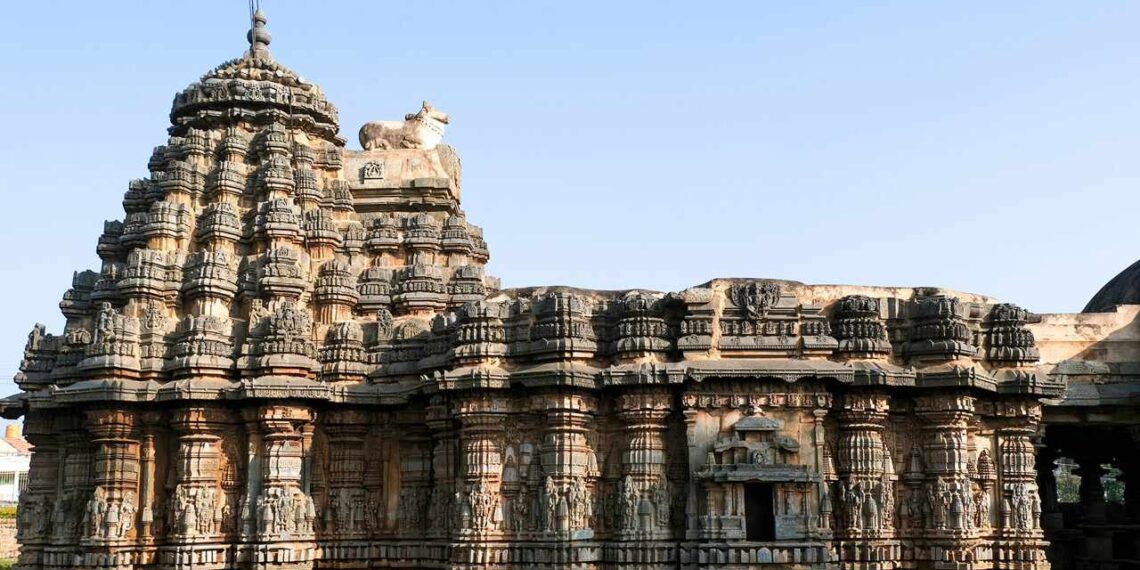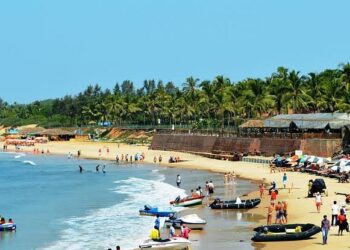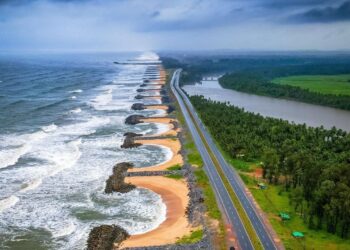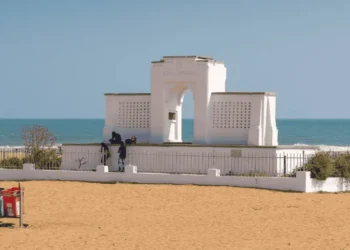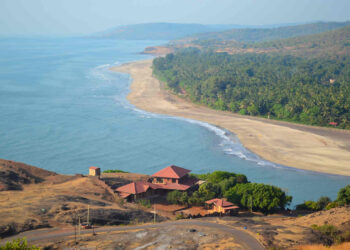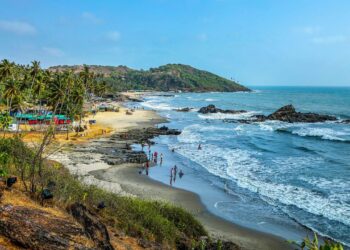Karnataka, a state nestled in South India, is home to thousands of Hindu temples, built by great dynasties like the Chalukyas, Hoysalas, Vijayanagaras, and Wodeyars. These shrines, known for their unique architecture, deep history, and the devotion they inspire, stand as pillars of Karnataka’s spiritual and cultural heritage. From delicate stone carvings to soaring gopurams, they reflect the deep devotion and heritage. Below are 10 notable temples in Karnataka, each with its own tale, which invite thousands of devotees from all around India and abroad.
1. Virupaksha Temple, Hampi
The Virupaksha Temple in Hampi, built in the 7th century by the Chalukyas, is dedicated to Lord Shiva as Virupaksha. A UNESCO World Heritage Site, it’s one of India’s oldest temples still in use, set by the Tungabhadra River. The 160-foot gopuram, added by Vijayanagara kings in the 15th century, has carvings of Shiva’s stories. Its halls and courtyards come alive during Hampi Utsav in November, with music and dance. The Maha Shivaratri chariot procession pulls thousands of devotees, showing its cultural importance.
2. Chennakeshava Temple, Belur
The Chennakeshava Temple in Belur, built in 1117 CE by Hoysala king Vishnuvardhana, is dedicated to Lord Vishnu as Chennakeshava. Its Hoysala architecture shines with walls full of carvings from celestial dancers, gods, to animals including this temple on UNESCO’s tentative list. The star-shaped base and 48 pillars in the main hall show fine work in construction. The Ratha Yatra in March or April has Vishnu’s murti(idol) on a wooden chariot.
3. Hoysaleswara Temple, Halebidu
The Hoysaleswara Temple in Halebidu, constructed in the 12th century by Hoysala king Vishnuvardhana, is dedicated to Lord Shiva. Its twin shrines and over 1,000 carvings of myths, warriors, and daily life make it a Hoysala marvel, also on UNESCO’s world heritage list. The walls show various scenes from the Ramayana and Mahabharata. Mahashivaratri brings all-night prayers, and Halebidu Utsav in January hosts dances in the courtyard.
4. Durga Temple, Aihole
The Durga Temple in Aihole, from the 7th century under the Chalukyas, is dedicated to Goddess Durga. Part of Aihole’s temple group, a birthplace of Indian temple design, it has a rare curved end. Carvings show Mother Durga killing Demon Mahisasura. The pillared hall and small gopuram mark early Dravidian style of the temple structure. Navaratri in September or October is celebrated with dance and music and various offerings for the goddess’s power.
5. Badami Cave Temples, Badami
The Badami Cave Temples, cut and later into cliffs in the 6th century by the Chalukyas, are four shrines dedicated to Shiva, Vishnu, and Jain Tirthankaras respectively. Red sandstone walls hold carvings of Lord Vishnu’s forms, Lord Shiva’s dance, and Jain figures. The third cave, with a 60-foot front, is the biggest among them, showing exquisite Chalukya art. Badami Utsav in February brings cultural shows in the temple complex. Also on UNESCO’s tentative list, these caves show Karnataka’s early temple-building ways.
6. Chamundeshwari Temple, Mysuru
The Chamundeshwari Temple on Chamundi Hills in Mysuru, built in the 12th century by the Hoysalas and later grown by the Wodeyars, is dedicated to Goddess Chamundeshwari, a form of Mother Durga. The seven-story gopuram and silver gates are one of the unique structures in the temple complex. The temple ties to the story of Chamundeshwari slaying Mahishasura, naming the place Mysuru. Dussehra in October, part of Mysuru’s huge Dasara, has cultural processions and prayers, drawing many devotees.
7. Banashankari Temple, Badami
The Banashankari Temple, near Badami, was built in the 7th century under the Chalukyas, dedicated to Goddess Banashankari, a form of divine shakti. Rebuilt in the 17th century after being destroyed by the Islamic invaders, it has a black stone murti(idol) and a big tank, Haridra Tirtha, for rituals. The Dravidian gopuram and pillared hall have simple carvings. Banashankari Jatre in January or February includes a fair and chariot march, showing local faith and devotion.
8. Sringeri Sharada Peetha, Sringeri
The Sringeri Sharada Peetha in Sringeri, constructed in the 8th century by Adi Shankaracharya, is dedicated to Goddess Sharada, a form of Goddess Saraswati. One of four Advaita Vedanta centers, it has a 13th-century temple rebuilt by Vijayanagara kings after being destroyed in Islamic invasion. The riverside site has a small gopuram and carvings of Vedic scholars. Navaratri has big rituals, and the temple’s library holds old texts. Its key role in Advaita makes it a key pilgrimage stop for those in the same path.
9. Gokarna Mahabaleshwar Temple, Gokarna
The Gokarna Mahabaleshwar Temple in Gokarna, built around the 4th century and later expanded by Kadamba kings, is dedicated to Lord Shiva as Mahabaleshwar. Also known as “Dakshina Kashi,” meaning ‘Kashi of the South’, it holds the Atmalinga, linked to Ravana’s penance. The Dravidian gopuram and wooden halls have carvings of Shiva’s forms. In Maha Shivaratri sea baths and worship of the lingam is performed by numerous devotes.
10. Udupi Sri Krishna Matha, Udupi
The Udupi Sri Krishna Matha, founded in the 13th century by Madhvacharya, is dedicated to Lord Krishna. Part of eight mathas, it houses a a small Krishna murti seen through a silver window, as a special tradition of the Matha. The gopuram and pillared halls show Vishnu’s avatars in intricate carvings. The Paryaya festival occurring every two years, marks the change of temple management with music and procession. Udupi’s temple kitchens is very famous for the prasadam offered to the devotees.
Conclusion
Karnataka’s temples, from Hampi’s ancient Virupaksha to Udupi’s serene Sri Krishna Matha, carry the state’s deep Hindu faith and artistic past. Built by dynasties like the Chalukyas, Hoysalas, and Vijayanagaras, these temples are one of the best from Karnataka showing fine carvings, grand designs, and intense rituals that shape Karnataka’s ways.
